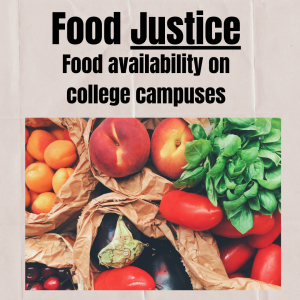Written by Allegra Latimer

College–the usual bustle between classes, Saturday football, and late nights with friends, thismight be what you think of when you think of the traditional college experience, right?
Well, in the midst of a global pandemic, college has been anything but traditional. 2020, among other things, has been a year of change. With Zoom meetings, virtual classes, and remote work, 2020 has called for us to adapt to life online. However, even though college is online, this doesn’t mean that college students don’t face the same real-world challenges and insecurities with any lessening degree.
Even before this non-traditional semester, for many students, their college experience took on a non-traditional path with nearly “71% of students experiencing circumstances of financial independence, part-time enrollment, full-time work while in school, or caretaking of dependents” (Feeding America).
Beyond the immediate stress of classes, there exists the larger stress of financial insecurity. From daily expenses to the steadily rising costs of tuition, college bills don’t distinguish between online or in-person––the challenge is the same.
So where does food insecurity enter the conversation?
Food insecurity is defined as “a lack of consistent access to enough food for an active, healthy life” (Feeding America). And as of 2017, 47% of Ole Miss students felt some degree of food insecurity. Of that number, 18-20% felt an impacting degree of food insecurity (Grove Grocery). Prioritizing education over food or vice versa should not be a question that one has to ask themselves; however, for many students, this question exists as a daily reality.
Financial insecurity stands as the root of the problem. Being college students we often find ourselves in a transitional period; having the independence to move out of our parents’ house, but still in the process of continuing our education towards a future career. Money, or the lack of it, lends itself to the all-too-real stigma of being a “broke college student.” The result leaves many having to face a difficult reality.
What is being done?
Food insecurity is a serious problem, though one that the UM Campus is fighting to change. Campus resources such as the Grove Grocery, formally known as the UM Food Bank, are working to ensure that all students have access to food. The Grove Grocery is available for all students/faculty as or when needed.
And just as most everything this semester has undergone some form of virtual adaptation, the Grove Grocery is offering contactless “Grab and Go” meals and grocery orders that students can place and later pick-up just as they would at any grocery store.
What can you do?
The move to end food insecurity does not stop there, and is one that is being fought from every angle. Especially on college campuses, there is no shortage of food; rather, the issue exists in access and distribution of this food, a reality further tied into food waste.
Student-led groups such as Flower of Life Food Rescue are working to not only provide food to low-income areas of the LOU Community, but also to spread awareness about the wastes of mass consumerism and socioeconomic inequality.
In many ways, fighting injustice is about first spreading awareness of the problem. The more people that are aware of the issue of food insecurity, the more that can be done about it. As college students looking to get involved, joining these groups and volunteering throughout the community is a significant step in the right direction, only taking a small amount of time out of your week to make a huge difference.
Written by Allegra Latimer
Green Student Intern